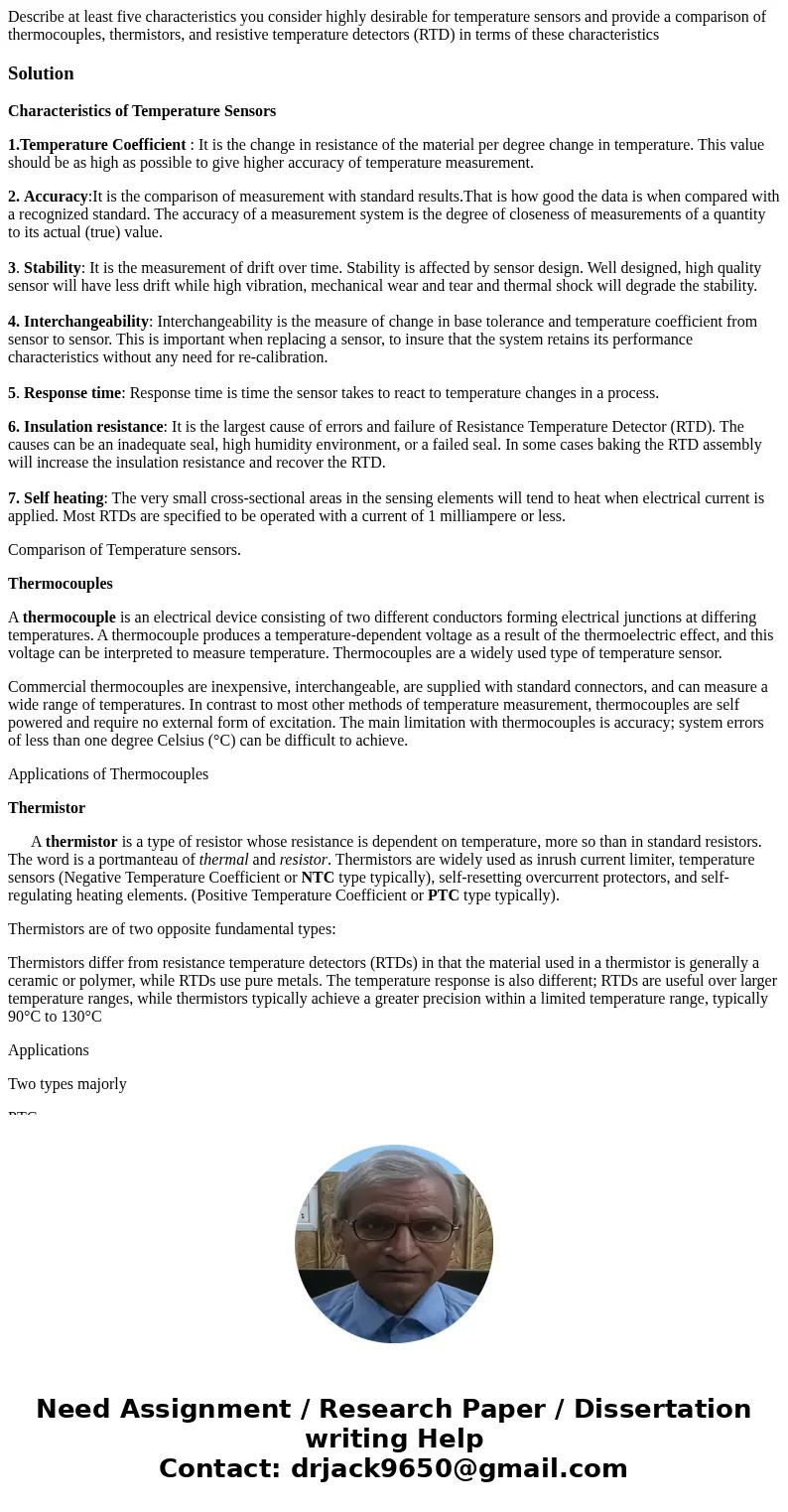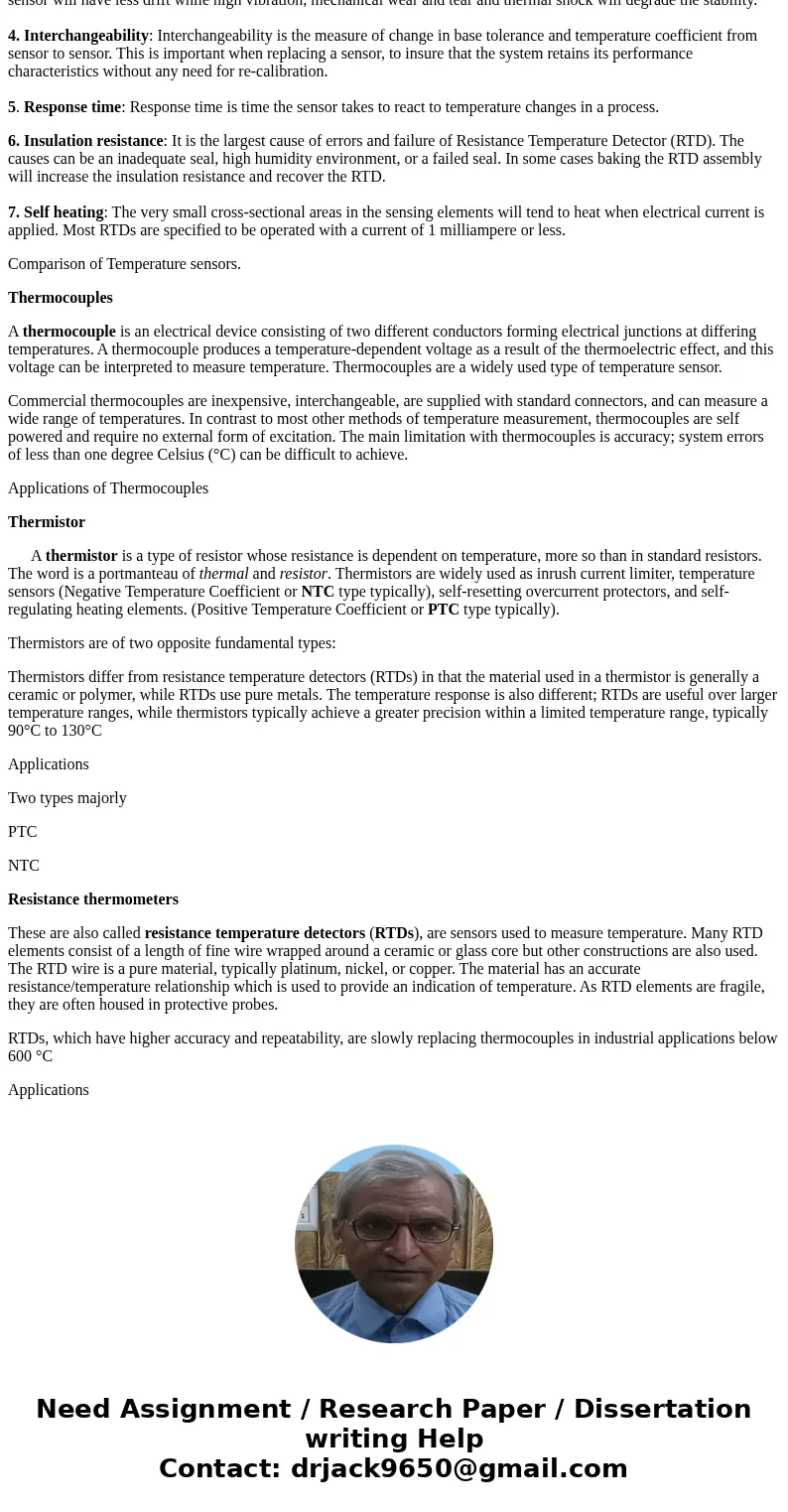Describe at least five characteristics you consider highly d
Describe at least five characteristics you consider highly desirable for temperature sensors and provide a comparison of thermocouples, thermistors, and resistive temperature detectors (RTD) in terms of these characteristics
Solution
Characteristics of Temperature Sensors
1.Temperature Coefficient : It is the change in resistance of the material per degree change in temperature. This value should be as high as possible to give higher accuracy of temperature measurement.
2. Accuracy:It is the comparison of measurement with standard results.That is how good the data is when compared with a recognized standard. The accuracy of a measurement system is the degree of closeness of measurements of a quantity to its actual (true) value.
3. Stability: It is the measurement of drift over time. Stability is affected by sensor design. Well designed, high quality sensor will have less drift while high vibration, mechanical wear and tear and thermal shock will degrade the stability.
4. Interchangeability: Interchangeability is the measure of change in base tolerance and temperature coefficient from sensor to sensor. This is important when replacing a sensor, to insure that the system retains its performance characteristics without any need for re-calibration.
5. Response time: Response time is time the sensor takes to react to temperature changes in a process.
6. Insulation resistance: It is the largest cause of errors and failure of Resistance Temperature Detector (RTD). The causes can be an inadequate seal, high humidity environment, or a failed seal. In some cases baking the RTD assembly will increase the insulation resistance and recover the RTD.
7. Self heating: The very small cross-sectional areas in the sensing elements will tend to heat when electrical current is applied. Most RTDs are specified to be operated with a current of 1 milliampere or less.
Comparison of Temperature sensors.
Thermocouples
A thermocouple is an electrical device consisting of two different conductors forming electrical junctions at differing temperatures. A thermocouple produces a temperature-dependent voltage as a result of the thermoelectric effect, and this voltage can be interpreted to measure temperature. Thermocouples are a widely used type of temperature sensor.
Commercial thermocouples are inexpensive, interchangeable, are supplied with standard connectors, and can measure a wide range of temperatures. In contrast to most other methods of temperature measurement, thermocouples are self powered and require no external form of excitation. The main limitation with thermocouples is accuracy; system errors of less than one degree Celsius (°C) can be difficult to achieve.
Applications of Thermocouples
Thermistor
A thermistor is a type of resistor whose resistance is dependent on temperature, more so than in standard resistors. The word is a portmanteau of thermal and resistor. Thermistors are widely used as inrush current limiter, temperature sensors (Negative Temperature Coefficient or NTC type typically), self-resetting overcurrent protectors, and self-regulating heating elements. (Positive Temperature Coefficient or PTC type typically).
Thermistors are of two opposite fundamental types:
Thermistors differ from resistance temperature detectors (RTDs) in that the material used in a thermistor is generally a ceramic or polymer, while RTDs use pure metals. The temperature response is also different; RTDs are useful over larger temperature ranges, while thermistors typically achieve a greater precision within a limited temperature range, typically 90°C to 130°C
Applications
Two types majorly
PTC
NTC
Resistance thermometers
These are also called resistance temperature detectors (RTDs), are sensors used to measure temperature. Many RTD elements consist of a length of fine wire wrapped around a ceramic or glass core but other constructions are also used. The RTD wire is a pure material, typically platinum, nickel, or copper. The material has an accurate resistance/temperature relationship which is used to provide an indication of temperature. As RTD elements are fragile, they are often housed in protective probes.
RTDs, which have higher accuracy and repeatability, are slowly replacing thermocouples in industrial applications below 600 °C
Applications


 Homework Sourse
Homework Sourse